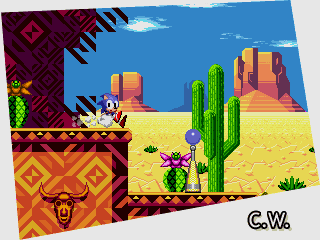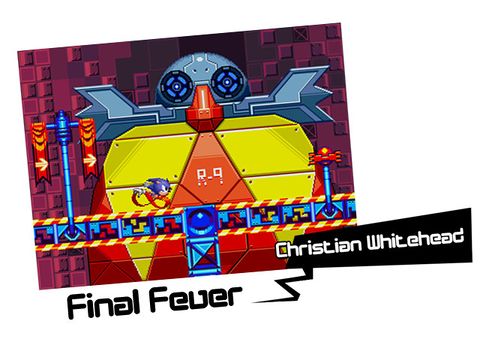Development:Sonic the Hedgehog CD (2011)
This page details development materials of Sonic the Hedgehog CD (2011).
| This article is a work in progress. ...Well, all the articles here are, in a way. But this one moreso, and the article may contain incomplete information and editor's notes. |
Contents
Retro Sonic
Retro Sonic was a fan game project by Christian "The Taxman" Whitehead which would, later on, become the Retro Engine. Also, this fan game already contained future elements of Sonic games, such as Breakable Wall for certain characters, Hyper Ring, which would later be added and updated in Sonic Mania, and the game is full of such elements.
The earliest incarnation of this game was created using Multimedia Fusion. Quickly realizing MMF's limitations, Taxman started bringing the engine over to Visual Basic which, along with the usage of the Direct X API, resulted in a better performance and allowed for more graphical effects.
First Version
March 20th 2002, he released a first demo (The 1st version of the engine, which didn't even have a name yet) that included a few playable Zones: Egg Garden Zone, Dust Hill Zone (Past and Present) (which was made from screenshots of the scrapped Zone for Sonic 2 named "Sand Shower Zone"), and Warehouse Zone (only Act 1 does not have a full-fledged level structure, only a SignPost), along with a Special Stage (the idea of collecting spheres, jumping over springs, not being able to stop, avoiding bombs, countdown, a special race track will later be redone and added to Sonic Mania).
This time, the engine was rewritten into the C++ using the existing code present in the Visual Basic version. Now created from scratch, the newest incarnation was programmed to be flexible, allowing for it to be ported easily to other platforms.
Second Version
July 10th 2006, he created a proof of concept that showed Retro Sonic running on the Dreamcast. One year later, August 13th 2007, a Windows demo of the game was released for the year's Sonic Amateur Games Expo. It featured updated Egg Garden Zone, new Special Stage (Sonic CD's Special Stage Test like in 510 Prototype) and a custom rebuild of Sonic 2's Emerald Hill Zone, which will be finalized and added to the remaster of Sonic 2, but already on the 4th version of the engine, but for now it was the 2th version of the engine, which named "Retro-Sonic C++ Engine Version 2". Knuckles was also added as a playable character, along with the ability to combine characters, which would later be added to the Sonic 1 and Sonic 2 remasters.
In this version, the “Mode 7” effect appeared for the first time for Egg Garden Zone and Special Stage.
Sega, Whitehead and Touch Arcade
July 27th 2009, Sega announced which of their games they would like to release in the iOS App Store.
Any idea is welcome, no matter how out there or random, we’ll take it and add it the list for the presentation. There are some restrictions, but that’s expected, right? First, it has to be a Sega game, meaning no other publisher’s titles, even if they did appear on our old systems (I know, I know, I want to see a Road Rash sequel too). Second, we can’t accept original game ideas, we’re not looking for acquisitions for new titles in this brainstorming session. And that’s pretty much it, go to town and tell us what you want to see.
— Blog Sega
July 28th 2009, 12:17 AM, Christian Whitehead post on Twitter to get SEGA involved in the development of Sonic CD.[1].
@SEGA
http://www.christianwhitehead.com/soniccd/view.html (The link now redirects to the Evening Star Studio website) This is what you should do for the iPhone, that is all, you know who to call...— Christian Whitehead
On July 29th, 2009, Christian Whitehead told Touch Arcade about his engine, which is now officially titled the Retro Engine, showed the RSDK (Retro Software Development Kit), and suggested that SEGA port the Sonic CD.
December 28th 2009, Christian Whitehead showcased for Touch Arcade a concept demo of the game being played on his iPod touch, in which only the first act of Palmtree Panic was available.[2] The port is not a direct emulation of the original Sega CD version, but rather it was developed from scratch using Whitehead's Retro Engine. He then contacted Sega to tell them about his release plans. As a result, SEGA heard his request and entrusted him with porting the game, as he himself wrote on his blog (October 19th, 2011).[3]
The version provided for Touch Arcade is a test version, so there are some differences in it. Here are some of them:
- At 0:53, the Sonic CD logo is taken from the European cover of the game for Windows 95.
- At 1:02, the cover of the Japanese version of the game for Windows 95 is taken as a BG image.
- At 1:08, it is visible that Whitehead took the SEGA logo, background, and Sonic sprites on the Title Screen from the Windows 95 version.
- At 1:30, the D-Pad and Jump sprites are different; in the final version, there will be a pixel version of the SEGA Genesis Controller sprites from the 2009 iPhone version of Sonic the Hedgehog.
- The prototype control icons are still in the Game Files Items2.gif, for Sonic and Tails.
| Proto | Final |
|---|---|
 |
 |
- At 0:12 and at 1:41, it is noticeable that the camera behavior was based on the original version of the game instead of strictly central as it will be in the final version of the game.
- At 1:51 and at 2:13, the game slows down due to music loading; apparently, it was still a test of the 3rd version of the Retro Engine.
- The Pause button are not visible in the video.
- At 4:03, the Signpost is not in the center but slightly to the right.
August 25th, 2011, SEGA has told GamesRadar that there were no plans for a WiiWare release, the reason for this is that game data and the CD quality sound won’t fit within Nintendo’s strict 40MB file size limit for games on the platform.
In Mid-2011, Taxman posted an update on his blog, stating that he had become busy working on a title set to release later that year, which was later revealed to be the 2011 port of Sonic CD. The port was made using an updated version of Retro Sonic's engine, the 3rd version.
R2 Zone (Desert Dazzle)
| To do: Desert Dazzle seems to be removed from the Sega Forever rerelease, as the level entry for it in dev menu was removed. |
| Sound Test Image | In-Game |
|---|---|
According to Christian Whitehead, Desert Dazzle was a new level he was working on that ended up being cut for time and authenticity reasons. The level's graphical design was heavily influenced by the well-known desert mockup image that was sent to magazines to promote Sonic the Hedgehog 2 in the early 1990s. The image on the left can be accessed by entering the Sound Test code PCM: 32, DA: 8. After viewing the image, you'll be taken to the Stage Select with Tails as your character.
Oh man, that was not meant to be in there!
What you're seeing is basically all that was playable (although the wonky palette cycling must be because you've hacked it in over Palmtree Panic). The level design isn't anywhere near done, it's only a test to see what structures look nice / what ideas are worth pursuing. Same goes with the music - it's only playing the D.A. Garden track because there's nothing else to use.
Had it been done, Desert Dazzle would have been full length Round with time zones and new music. I'm quite fond of the art I made for it actually, it was somewhat of a happy accident coming up with those patterns and colours.
— Christian Whitehead
In the 1.0.2 update of iOS version, stage assets for both Desert Dazzle and Final Fever were discovered, complete with full-level maps. The video on the right is a mod of the PC version, which replaces Palmtree Panic's tiles and level layout with Desert Dazzle's. Because the stage was never finalized, no Badniks or gimmicks were ever implemented. The default background music for both soundtracks is the Time Attack theme (track 33).
Desert Dazzle would finally see the light of day in Sonic Mania, with its tiles reused/revised for Mirage Saloon Zone.
R9 Zone (Final Fever)
Final Fever was a level that planned to add, but ended up cancelling. It was intended to be a boss only for players who had collected all the Time Stones.
The level was to use the Final Fever boss music track from Metallic Madness 3. The Metallic Madness 3 boss would then use the normal boss music if all the Time Stones were collected.
Yeah, it's colourful since it was intended to be an all Time Stones boss (good future only). Time flows freely, and Eggman's machine is essentially invincible. The idea being Sonic can reach warp speed at any opportunity (instead of getting the warp posts) and must do so to "wind back the clock" to damage the boss. Some parts are running, some areas the screen is locked. I was slightly worried the idea of running to warp might not be self evident (no warp screen, the level and boss would change in real time with some neato effects).
— Christian Whitehead
I think I've mentioned it before a while back, but I had put together some early demo tracks for Desert Dazzle. Final Fever used the "Final Fever" track from Metallic Madness 3, with the MM3 boss taking on the regular boss tune when played with 7 time stones.
This is of course, ignoring the fact that we managed to have both the US and JP soundtrack in the end so if Sonic CD was ever expanded, the music situation would be interesting to say the least. In a dream world, Naofumi Hataya, Masafumi Ogata and Spencer Neilson would create some wonderful new tracks for it all.
— Christian Whitehead
Some elements would later be re-used in Sonic Mania, such as in the interior of Titanic Monarch Zone and the battle in a distorted Time Warp in Egg Reverie Zone.
Final Fever is thought to only be planned to appear in the 2011 version, however, Electronic Gaming Monthly Issue 49, which talks about the original version, has Final Fever listed as the last boss, suggesting it was originally planned for the original version.




